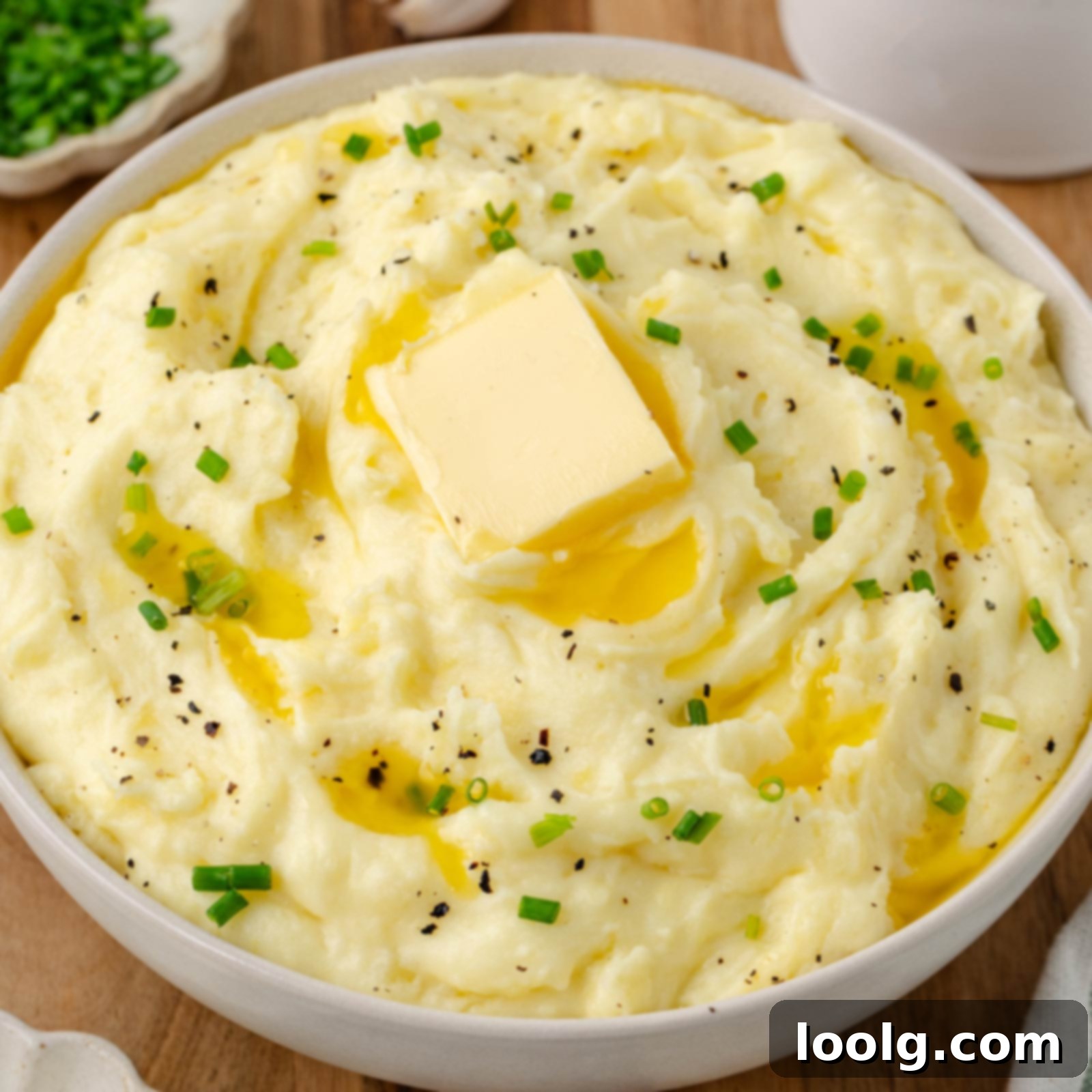Creamy & Fluffy Yukon Gold Mashed Potatoes: The Ultimate Recipe Guide
There’s a reason mashed potatoes hold a special place in our hearts and on our dinner tables. They are the quintessential comfort food, offering warmth, satisfaction, and a delightful texture that complements almost any meal. Among the myriad of potato varieties, Yukon Gold potatoes stand out as the undisputed champion for creating the most luxurious, creamy, and undeniably fluffy mashed potatoes. Their inherent buttery flavor and consistent texture make them an ideal choice, minimizing the need for excessive additions while delivering maximum taste.
This comprehensive guide will walk you through the secrets to achieving perfect mashed potatoes every single time, whether you prefer a traditional dairy-rich version or are looking for delicious vegan, paleo, dairy-free, or Whole30-friendly adaptations. Get ready to elevate your side dish game and steal the spotlight at your next gathering. These golden beauties are an absolute must-have for holiday feasts, perfectly accompanying main dishes like this Traeger Smoked Turkey, Smoked Turkey Breast, or any other flavorful meat centerpiece.
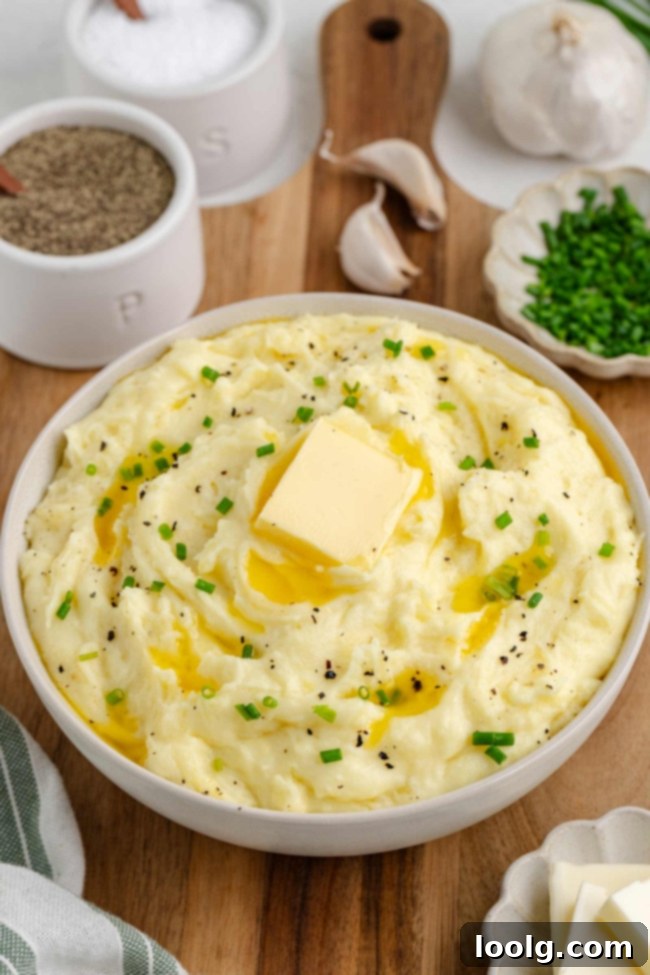
Why Yukon Gold Potatoes Are the Best Choice for Creamy Mashed Potatoes
While many potato varieties can be mashed, Yukon Golds possess a unique set of characteristics that make them truly superior for this particular application. Their medium starch content strikes a perfect balance, allowing them to break down easily for a smooth consistency without becoming gluey or watery – common pitfalls with other types of potatoes. This balance is key to achieving that coveted velvety texture that defines truly great homemade mashed potatoes.
Here’s a deeper look into why Yukon Gold potatoes are consistently recommended by chefs and home cooks for making the best mashed potatoes:
- Naturally Buttery Flavor: Unlike bland starchy potatoes, Yukon Golds have a distinct, subtly sweet, and buttery taste that enhances the overall flavor profile of your mashed potatoes. This natural richness means you can often use less added butter or cream, making them a healthier choice without sacrificing indulgence.
- Velvety Smooth Texture: Their dense yet smooth flesh transforms into an incredibly silky and creamy mash. They don’t turn crumbly like high-starch Russets (which are great for baking or frying but can be too dry for mash), nor do they remain waxy and firm like low-starch red potatoes (better for salads or roasting). Instead, Yukon Golds offer a luxurious mouthfeel that is neither heavy nor pasty. This excellent texture also makes them versatile for other dishes, such as this delightful Italian potato salad with green beans!
- Consistent Cooking and Easy Mashing: Yukon Golds cook evenly throughout, ensuring that every piece is perfectly tender at the same time. This uniform cooking prevents hard bits or overcooked mush, saving you time and effort when it comes to mashing. Their inherent creaminess makes them incredibly easy to mash with minimal effort, whether you’re using a hand masher or an electric mixer, contributing to truly fluffy mashed potatoes.
Opting for Yukon Gold potatoes is your first step towards achieving perfectly creamy and delicious mashed potatoes that will impress everyone at the dinner table. They deliver consistent results, making them a reliable choice for any occasion, from simple weeknight dinners to elaborate holiday feasts.
Essential Ingredients for Your Golden Mashed Potatoes Recipe
Crafting the perfect batch of rich, creamy mashed potatoes starts with selecting high-quality ingredients. Here’s a detailed overview of what you’ll need to achieve that signature creamy, buttery flavor and smooth texture:
- Yukon Gold Potatoes (3 pounds / 1360 grams): The star of our show, providing that natural buttery flavor and ideal texture. This quantity is perfect for serving 6-8 people generously.
- Whole Milk (3/4 cup / 175 ml): Contributes to the creamy consistency and adds a touch of richness. Warm milk blends more smoothly into the potatoes.
- Heavy Cream (3/4 cup / 175 ml): Elevates the luxuriousness, providing a rich mouthfeel and incredible flavor. Combined with whole milk, it creates the ultimate creamy base.
- Garlic Cloves (5, minced): Freshly minced garlic adds an aromatic depth that is simply irresistible and complements the buttery potatoes beautifully. If fresh garlic isn’t available, you can substitute with 1 1/4 teaspoons of granulated garlic or 5/8 teaspoon of garlic powder for a milder, more diffused garlic flavor.
- Unsalted Butter (3/4 cup / 168 grams): Essential for that classic buttery taste and smooth texture. Using unsalted butter gives you full control over the salt content of your dish, allowing you to season perfectly.
- Salt (1 1/2+ teaspoons): Crucial for seasoning and enhancing all the other flavors. Potatoes absorb a lot of salt, so don’t be shy, but always start with the recommended amount and adjust to taste at the end.
We’ll delve into suitable dietary-friendly substitutions in a dedicated section further down, ensuring everyone can enjoy these amazing mashed potatoes, whether they are traditional, vegan, dairy-free, paleo, or Whole30.
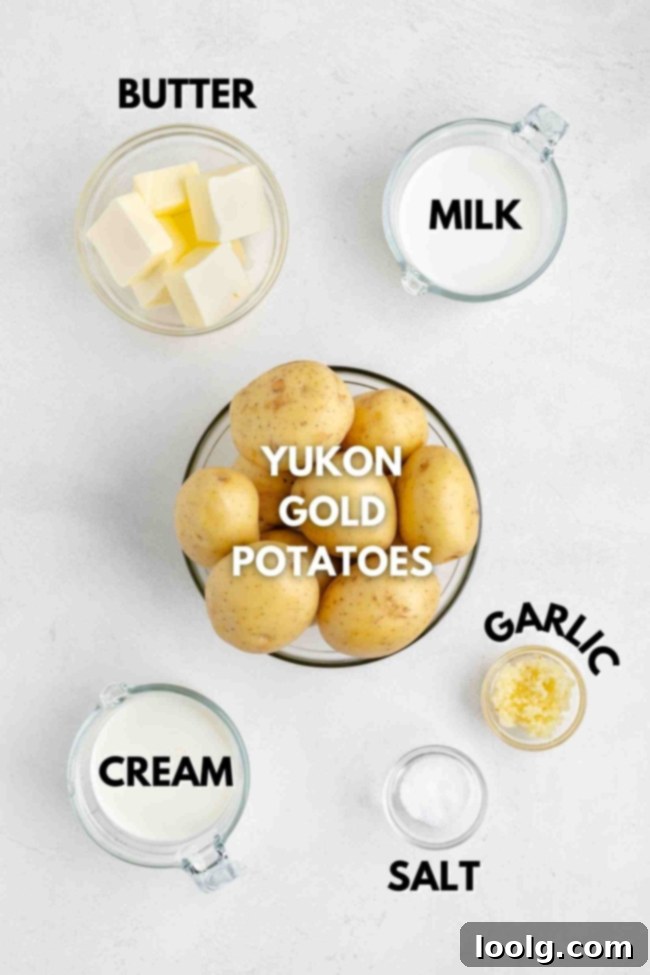
How to Make Perfect Mashed Potatoes: Avoiding the Gummy Trap
Many home cooks have faced the dreaded “gummy” mashed potatoes, a common issue often caused by overworking the starch or introducing too much water. While boiling potatoes together might seem straightforward, as in some recipes like the Cheesy Mashed Potatoes I shared recently, it can often lead to waterlogged potatoes that refuse to absorb butter and milk properly, resulting in an unappealing, gluey texture. Through extensive research and experimentation, I’ve perfected a technique that consistently delivers light, fluffy, and creamy homemade mashed potatoes. Follow these steps for guaranteed success every time:
1. Prepare and Rinse Your Potatoes Properly
This initial step is foundational and often underestimated, yet it makes a significant difference in the final texture of your mashed potatoes. After washing and peeling your Yukon Gold potatoes, cut them into uniform 1-inch chunks. Uniform pieces ensure even cooking, which is crucial for a consistent, lump-free texture. Once cut, place the potato chunks in a colander and rinse them thoroughly under cold running water for several minutes. This critical step removes excess surface starch, a primary culprit behind gummy mashed potatoes. Reducing this starch early on sets the stage for a lighter, fluffier result, allowing the potatoes to absorb the rich flavors better.
2. Steam, Don’t Boil, Your Potatoes for Best Results
This is perhaps the most significant departure from traditional methods and a game-changer for achieving truly perfect mashed potatoes. Boiling potatoes submerges them in water, causing them to absorb excess moisture, making them waterlogged and diluted in flavor. This absorbed water then prevents the potatoes from properly absorbing the rich flavors of milk and butter later on, leading to bland and often gummy results. Steaming, however, cooks the potatoes gently with moist heat, allowing them to become perfectly tender without becoming saturated with water. This method ensures your potatoes retain their natural flavor and texture, becoming light and airy rather than heavy and dense.
To steam, add about an inch of water to a large pot and insert a steaming basket. Bring the water to a boil, then carefully add the rinsed potato chunks to the basket. Cover the pot tightly with a lid to trap the steam, reduce the heat to medium, and steam for approximately 20-30 minutes, or until the potatoes are fork-tender. They should be easily pierced with a fork but not falling apart.
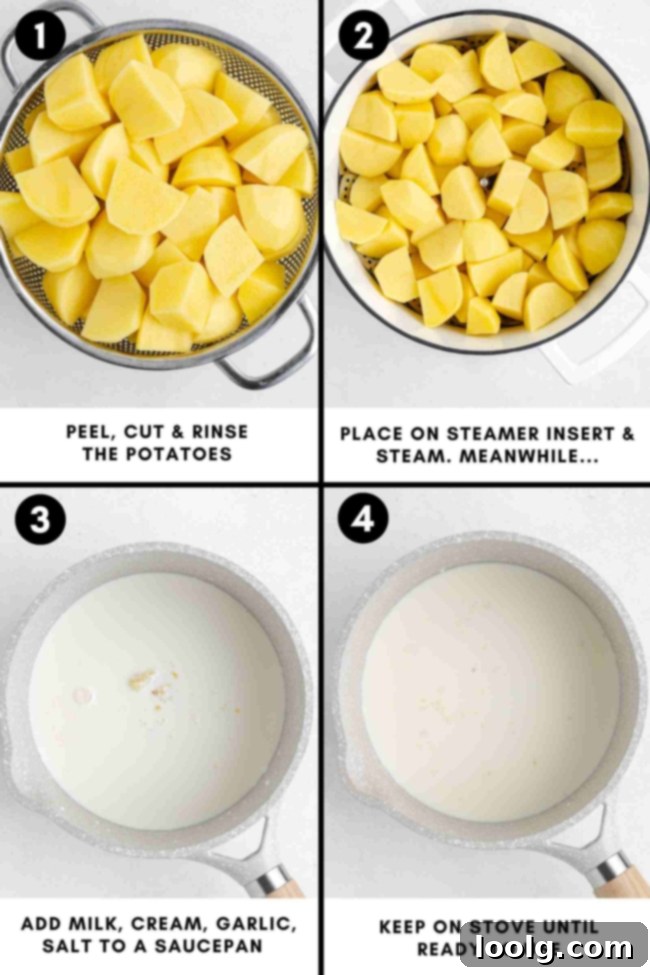
3. Dry the Potatoes After Steaming – A Crucial Step for Fluffiness
Once your potatoes are perfectly tender from steaming, it’s essential to remove any residual moisture. Carefully remove the steaming basket from the pot and drain any water remaining in the pot. Immediately return the steamed potatoes directly to the empty, hot pot. Place the pot back on the burner (with the heat off, or on the very lowest setting if your burner isn’t retaining much heat) and let them dry out for 1-3 minutes. Shake the pot occasionally to encourage even drying. This process evaporates any lingering surface moisture, which is vital for preventing gumminess and allowing the potatoes to fully absorb the butter and cream you’ll add next. This step ensures your mashed potatoes are light and fluffy, not dense or soggy.
4. Coat the Potatoes in Butter Immediately
This step is where the magic begins to happen for a truly creamy texture and to prevent the starches from becoming gluey. As soon as the potatoes are dry and hot, add the unsalted butter directly to the potatoes in the pot. With a large spoon or silicone spatula (or with your electric hand mixer turned off, just to break up large chunks), gently stir the butter into the potatoes. The residual heat from the potatoes will quickly melt the butter, thoroughly coating the individual potato pieces. This creates a protective layer of fat around the starch granules, preventing them from interacting excessively with the water content in the milk and cream that will be added next. This crucial coating is precisely what helps maintain a smooth, non-gummy, and incredibly fluffy texture as you mash them.
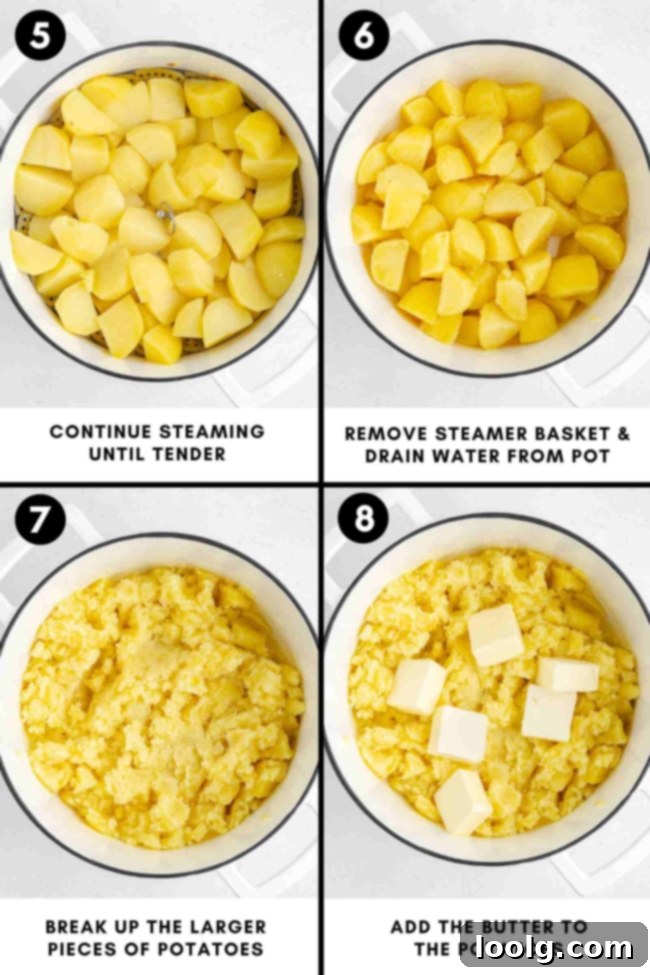
5. Mash Them Right Away with the Right Tool
Timing is everything when it comes to mashing. I’ve personally experienced the disappointment of letting perfectly cooked potatoes sit for an hour or two before mashing, only to find they develop a poor, often gluey or overly firm texture. This happens because the starches begin to retrograde and re-bind once cooled. Therefore, steam your potatoes, dry them, coat them in butter, and then mash them immediately – do not let them linger!
When it comes to mashing tools, choose wisely to achieve your desired texture. A traditional **potato masher** works well for a slightly rustic texture with small lumps. For truly smooth and airy results, an **electric hand mixer** is excellent, but be careful not to overmix, as this can activate too much starch and lead to gumminess. A **potato ricer** is another fantastic option for achieving an incredibly fine, uniform texture without overworking the potatoes, pushing them through small holes to create delicate strands. For a silky-smooth finish, a ricer is often considered the gold standard.
Once the butter is incorporated, gradually add the warm milk and cream mixture in three additions, using your chosen mashing tool. Start on a low speed with an electric mixer to avoid splatters, then increase to high and beat until smooth and creamy. Remember, the full amount of liquid specified in the recipe is necessary for the ideal consistency – resist the urge to reduce it. Overmixing is the enemy here; stop as soon as the potatoes are smooth and creamy. Taste and add more salt or pepper if needed.
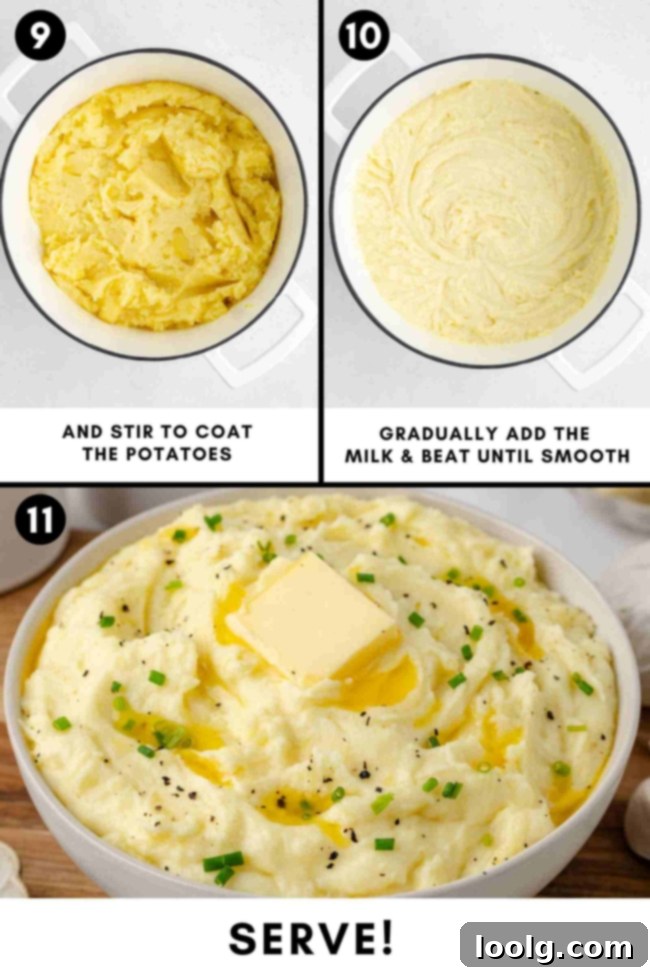
Prepare Ahead: Make-Ahead & Reheating Tips for Mashed Potatoes
One of the best features of this Yukon Gold mashed potato recipe is how well it lends itself to make-ahead preparation, a huge advantage for busy weeknights or elaborate holiday meals. Preparing them in advance allows you to reduce stress and focus on other dishes without sacrificing quality or flavor. Follow these tips to store and reheat your delicious mashed potatoes for optimal results:
- Preparation & Cooling: Prepare the mashed potatoes exactly as directed in the recipe, ensuring they reach their perfect creamy consistency. Once they are finished, allow them to cool completely at room temperature for about an hour. This is crucial before refrigeration to prevent condensation build-up and ensure proper food safety and texture.
- Refrigeration: Store the cooled mashed potatoes in an airtight container in the refrigerator for up to 4 days. A casserole dish covered tightly with foil or plastic wrap also works well. This makes them a perfect component for meal prepping ahead of a big event like Thanksgiving or Christmas.
- Reheating on the Stovetop (Recommended): For best results, reheat your mashed potatoes on the stovetop. Transfer the refrigerated potatoes to a large saucepan or pot. Begin reheating over low heat, adding a splash of milk or cream (dairy or your chosen dairy-free alternative) at a time. The cold potatoes will be quite stiff, but as they warm, they will loosen. Stir frequently to ensure even heating and prevent sticking to the bottom of the pan. Gradually increase the heat to medium-low, continuing to stir and add small amounts of liquid until the potatoes restore their original creamy, fluffy consistency. Taste and adjust seasoning as needed, as flavors can mellow during storage.
- Reheating in the Oven: For larger batches, you can reheat in the oven. Transfer cold mashed potatoes to an oven-safe dish, add a few splashes of milk or cream, and dot with butter. Cover tightly with foil and bake at 350°F (175°C) for 20-30 minutes, or until heated through, stirring halfway.
- Freezing: Mashed potatoes freeze surprisingly well! You can freeze them for up to 3 months. To freeze, let the mashed potatoes cool completely, then transfer them to freezer-safe bags (flattened to remove air and allow for quicker thawing) or airtight containers. Thaw them overnight in the refrigerator before reheating. Reheat frozen-then-thawed potatoes using the same stovetop method described above, adding liquid as necessary.
This make-ahead method is particularly invaluable for holiday meal prep, granting you the freedom to dedicate your attention to other aspects of your feast, all while ensuring your creamy mashed potatoes are just as perfect as if they were freshly made.
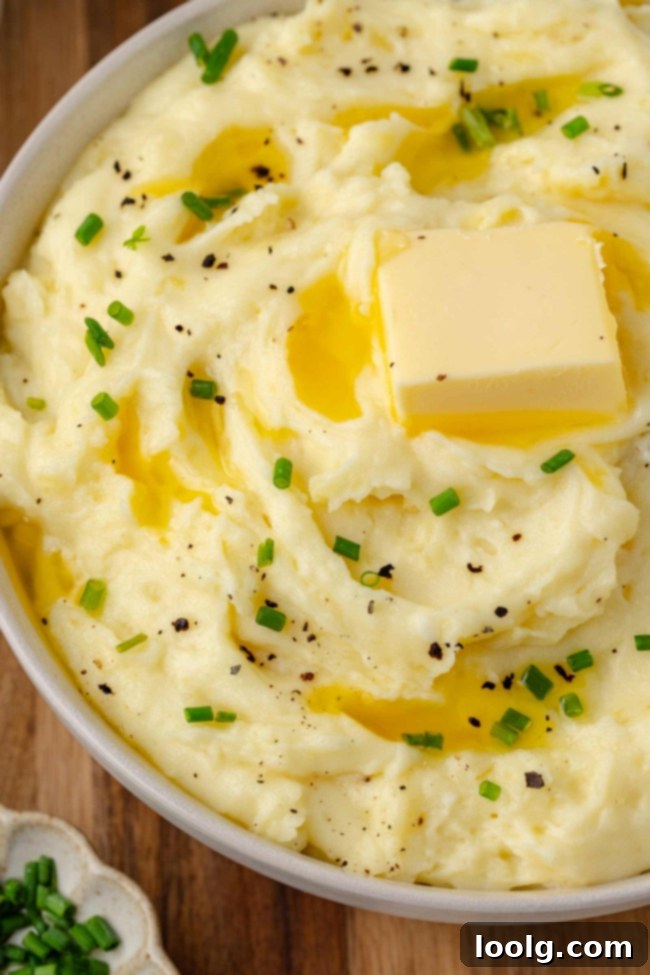
Exciting Flavor Variations to Elevate Your Mash
While classic Yukon Gold mashed potatoes are undeniably delicious on their own, they also serve as a fantastic canvas for culinary creativity. You can easily customize them with a variety of additions to suit your taste preferences or complement your main course. Here are some ideas to infuse new life into your creamy mash and make them even more special:
- Garlic Lover’s Dream: For an even more intense savory twist, instead of just minced raw garlic, stir in a head of roasted garlic puree or a drizzle of garlic-infused olive oil. Roasting garlic sweetens its flavor and makes it incredibly mellow, adding a sophisticated depth without the raw garlic bite.
- Tangy & Rich Additions: Introduce a delightful tanginess and extra richness by mixing in a few tablespoons of cream cheese, sour cream, or even Greek yogurt (for a lighter, brighter option). These ingredients add a lovely complexity and even creamier texture.
- Fresh Herb Infusion: Brighten up your mashed potatoes with a burst of freshness. Finely chop and stir in fresh herbs like chives, parsley, dill, or thyme. A blend of herbs like a classic “fines herbes” mixture can also be wonderful. Add them just before serving for the best flavor and vibrant color.
- Cheesy Indulgence: Transform your mash into a cheesy delight by folding in grated Parmesan, sharp cheddar, gruyere, or even a smoky Gouda. The cheese will melt into the warm potatoes, creating a gooey, flavorful experience. For a truly decadent dish, you can also bake the cheesy mashed potatoes in a casserole dish until golden brown on top.
- Smoky Bacon & Onion: Cook crispy bacon pieces until golden brown. Drain most of the fat, then sauté diced onions in the rendered bacon fat until caramelized and sweet. Stir both the crispy bacon and the sweet onions into your mashed potatoes for a savory, smoky, and textural contrast.
- Truffle Elegance: For an upscale touch, drizzle a small amount of high-quality white or black truffle oil into the finished mash. A little goes a long way to impart an earthy, luxurious aroma and flavor that will impress any guest.
- Spicy Kick: For those who love a bit of heat, consider stirring in a pinch of cayenne pepper, a dash of hot sauce, or finely minced jalapeños (deseeded for less heat) for a subtle spicy kick.
Experiment with these variations to find your new favorite, or combine a few for a truly unique and memorable side dish!
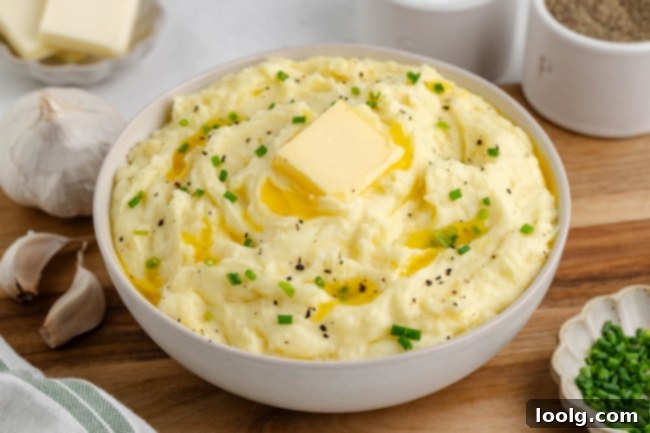
Troubleshooting Common Mashed Potato Problems
Even with the best intentions and following a great recipe, mashed potatoes can sometimes present challenges. Don’t worry, most issues are easily fixable! Here’s a guide to troubleshooting common problems and ensuring your mash is always perfect:
- Gummy Texture: This is the most common complaint and typically occurs when potatoes are overworked, causing their starches to release and become gluey. To prevent this, avoid using a food processor or blender, which will pulverize the potatoes and over-process the starches. Mash gently and only until smooth; stop as soon as the desired creamy consistency is reached. If your potatoes turn gummy, you can sometimes rescue them by adding a small amount of warm milk or cream and stirring very gently, but prevention (proper cooking, drying, coating, and gentle mashing) is always key.
- Too Thick: If your mashed potatoes are denser or stiffer than desired, simply add more warm milk or cream (or your chosen dairy-free alternative), a tablespoon at a time, until the ideal creamy consistency is achieved. Always add warm liquid to avoid cooling down the potatoes, which can affect their texture.
- Too Runny: If you’ve accidentally added too much liquid, don’t despair! Stir in a small amount of instant potato flakes, which are designed to absorb excess moisture without altering flavor. Alternatively, you can mash an extra boiled or steamed potato (prepared and dried separately) and fold it into the runny batch to thicken it naturally. Another trick is to gently heat the potatoes on the stovetop over low heat, allowing some of the excess moisture to evaporate, stirring constantly.
- Too Bland: Mashed potatoes need generous seasoning. If they taste flat, it’s likely they need more salt. Add salt gradually, tasting after each addition. A pat of butter, a pinch of garlic powder, or even a dash of onion powder can also enhance the flavor significantly. Freshly ground black pepper is also a great addition for depth.
- Lumpy Texture: If your mashed potatoes are lumpy, it usually means the potatoes weren’t cooked long enough, or they weren’t mashed thoroughly. Ensure potatoes are fork-tender throughout before mashing. If lumps persist after mashing, you can pass the mashed potatoes through a fine-mesh sieve or a potato ricer for an ultra-smooth finish.
Trust the Process: Stick to the Directions for Fluffy Mashed Potatoes!
I understand that when you see the recommended amount of liquid (whole milk and heavy cream) in this recipe, it might seem like a lot. Many people are tempted to reduce it, fearing their potatoes will turn soupy or thin. However, reducing the liquid is a common mistake that often leads to dense, gluey, or dry mashed potatoes. The precise balance of butter, milk, and cream in this recipe is crucial for achieving that consistently creamy and fluffy texture that sets these Yukon Gold mashed potatoes apart from the rest.
I have been making my mashed potatoes using this exact method and these specific quantities for years, and they always turn out perfectly. Even I, on occasion, find myself doubting the generous amount of liquid just before adding it, but I assure you, following the recipe as written will result in the most delicious, velvety smooth mashed potatoes you’ve ever made. Trust in the process, and you won’t be disappointed!
Perfect Pairings: What to Serve with Your Golden Mash
Creamy Yukon Gold mashed potatoes are an incredibly versatile side dish that complements a wide array of main courses, making them a perfect addition to any meal, especially holiday spreads. Their rich, comforting flavor and smooth texture pair beautifully with both savory meats and hearty vegetables, enhancing the overall dining experience. Here are some of our favorite main dishes that truly shine alongside these golden mashed potatoes:
- Smoked Turkey Legs
- Smoked Spatchcock Chicken
- Venison Backstrap
- Smoked Ribeye Recipe
- Chicken Leg Quarters Recipe – we often make these with potatoes roasted in the pan alongside the chicken, but these creamy mashed potatoes offer a delightful and luxurious change of pace!
Beyond these specific suggestions, consider serving them with classic roast beef, a succulent baked ham, perfectly grilled pork chops, or even a simple pan-seared salmon. They also make a fantastic, comforting base for rich pot pies or a savory shepherd’s pie. For a vegetarian option, pair them with roasted root vegetables or a hearty mushroom gravy. The comforting nature of these mashed potatoes truly makes them suitable for nearly any main course you can imagine, making them a staple in any cook’s repertoire.
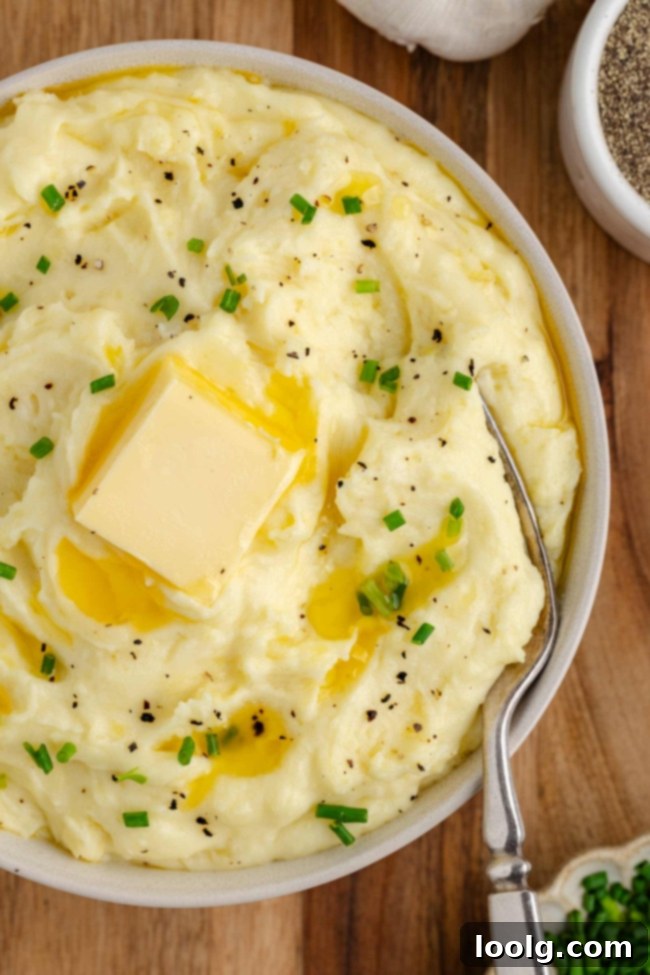
Dietary Adaptations: Vegan, Dairy-Free, Paleo, and Whole30 Options
The beauty of this Yukon Gold mashed potato recipe is its incredible adaptability. It’s remarkably easy to modify for various dietary needs, including vegan, dairy-free, paleo, and Whole30. In fact, these modified versions are often my go-to for healthy eating! Since potatoes themselves are naturally gluten-free, this dish is already a fantastic option for those avoiding gluten. For another amazing gluten-free side dish, I highly recommend this Gluten-free Mac and Cheese.
Here’s what you can use for successful dietary adaptations to create delicious dairy-free mashed potatoes:
- Dairy-Free Milk Substitute: Instead of whole milk, opt for unsweetened dairy-free milk like almond, cashew, oat, or soy milk. For those following a paleo diet, unsweetened almond or cashew milk are excellent choices. Be sure to choose varieties without added sugars, thickeners, or artificial flavors to maintain a neutral potato taste and avoid unwanted sweetness.
- Cream Alternative: Canned full-fat coconut milk (specifically the cream from the top of the can for maximum richness) is an outstanding substitute for heavy cream. It adds a wonderful richness and texture that closely mimics dairy cream, typically without a strong coconut flavor, especially when refined coconut oil and garlic are also present in the recipe. I generally don’t recommend replacing whole milk with coconut milk, as using a high volume can impart a noticeable coconut taste to the potatoes. Coconut milk works best for replacing the cream component specifically, where its high-fat content truly shines.
- Butter Alternatives:
- For paleo, Whole30, dairy-free, and vegan options, a combination of 6 tablespoons olive oil and 6 tablespoons refined coconut oil works perfectly. Refined coconut oil is absolutely key here as it has a neutral flavor, unlike virgin coconut oil which can have a distinct coconut taste that might not be desired in mashed potatoes. This combination provides the necessary fat for a rich, creamy texture.
- For dedicated dairy-free and vegan versions, you can use 3/4 cup of your favorite high-quality vegan butter. Many excellent brands are available today that mimic the flavor and texture of dairy butter incredibly well, providing that familiar buttery richness.
To ensure the best results with these substitutions, remember to use unsweetened dairy-free milks to keep the flavor profile neutral. If you prefer not to use coconut milk for the cream component, you can simply increase the amount of your chosen dairy-free milk, though this may result in a slightly less rich consistency due to lower fat content. The combination of refined coconut oil and garlic in the recipe helps to neutralize any subtle coconut notes from the canned coconut milk, ensuring your mashed potatoes taste classic, comforting, and utterly delicious, regardless of the adaptations.
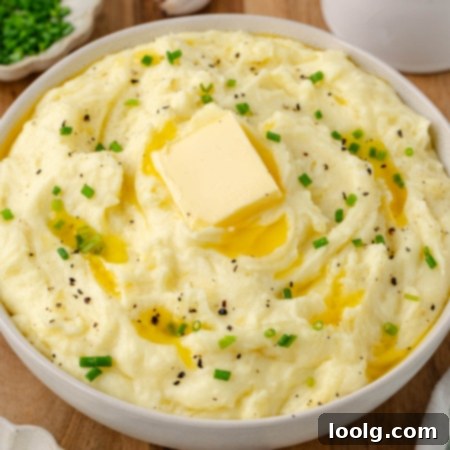
Yukon Gold Mashed Potatoes
Ingredients
- 3 pounds (1360 grams) Yukon Gold potatoes
- 3/4 cup (175 ml) whole milk
- 3/4 cup (175 ml) heavy cream
- 5 garlic cloves minced
- 1 1/2 + teaspoons salt
- 3/4 cup (168 grams) unsalted butter
Instructions
-
Wash and peel the potatoes and cut into 1″ chunks. Put them in a colander and rinse under cold water.
-
Get out a steaming basket and a pot that’s large enough for the steaming basket. Add an inch of water to the pot, and put in the steaming basket. Bring the water to a boil and add the potatoes to the steaming basket. Cover the pot with a lid.
-
Turn the heat down to medium and steam for about 20-30 minutes or until tender. They should be fully cooked.
-
Meanwhile, in a small saucepan over low heat, add the milk, cream, garlic, and salt (I recommend using 1 1/2 teaspoons and adding more later, if desired). Once it’s all melted, turn the heat off (but keep the saucepan on the stove so it stays warm).
-
Once the potatoes are fully cooked, remove the steamer basket from the pot and drain the water from the pot. Put the potatoes back into the pot and put the pot back on the burner (which is now off – if you have a gas or induction burner that’s not still hot, then turn the heat to the lowest setting). Let any remaining moisture cook off for 1-3 minutes, shaking the pot occasionally.
-
With an electric hand mixer (turned off) or a potato masher, break up the large potato pieces first. Stir in the butter (with a large spoon or silicone spatula) so that it coats the potatoes. It doesn’t have to be perfectly mixed in – it just has to be melted and coat the potatoes.
-
Add the milk mixture in 3 additions (using an electric hand mixer), starting off on low so that the liquid doesn’t fly everywhere and then turning it up to high and beat until smooth and creamy. You need the full amount of liquid. Do not overmix! Taste and add more salt, if needed.
-
Best if served immediately, as with all mashed potatoes. Let leftovers cool completely and then refrigerate in an airtight container for up to 4 days.
Notes
- Dairy-free milk (like almond, cashew, oat, or soy) instead of whole milk. If you’re paleo, use unsweetened almond or cashew milk.
- Canned coconut milk as a substitute for cream
- 6 tablespoons olive oil + 6 tablespoons refined coconut oil for paleo, Whole30, dairy-free, and vegan options OR 3/4 cup vegan butter for dairy-free and vegan
Nutrition
